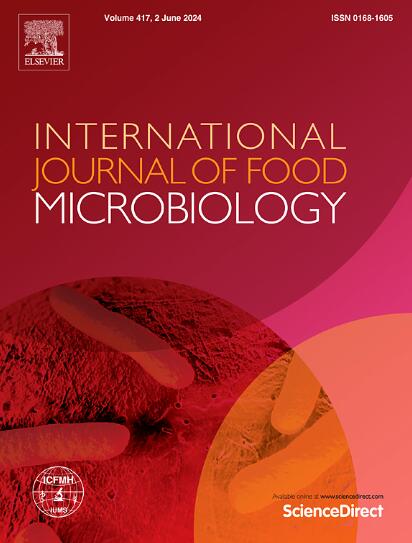Changes in microbial assembly and ecological processes following application of Aureobasidium pullulans on apple fruit surface
IF 5.2
1区 农林科学
Q1 FOOD SCIENCE & TECHNOLOGY
International journal of food microbiology
Pub Date : 2025-06-03
DOI:10.1016/j.ijfoodmicro.2025.111299
引用次数: 0
Abstract
The apple fruit surface hosts a diverse microbiome that plays a vital role in fruit health and resistance to postharvest decay. Aureobasidium pullulans, a core member of this microbiome, has been extensively studied for its biocontrol properties, yet its ecological role in shaping microbial community dynamics remains poorly understood. This study aimed to evaluate the effect of manipulating a native Aureobasidium, to act both as a biocontrol agent and as a modulator of the epiphytic microbiome when applied at different stages of fruit development and storage. Among 28 Aureobasidium isolates recovered from ‘Golden Delicious’ apple surfaces, A69 demonstrated the most potent antagonistic activity against Penicillium expansum through volatile and diffusible metabolite production and effective suppression of lesion development in fruit. While preharvest field applications had limited effects on microbial diversity, postharvest and combined treatments significantly reshaped both fungal and bacterial communities on the apple fruit surface. Notably, A69 treatments inhibited decay incidence in stored fruit, reduced fungal diversity and enriched beneficial bacterial and yeast genera including Vishniacozyma, Cystobasidium, Buckleyzyma, Bacillus, and Frigoribacterium, many of which exhibited antagonistic activity against key postharvest pathogens. Cross-kingdom network and ecological assembly analyses revealed that A69 promoted deterministic selection within fungal communities and fostered competitive microbial interactions, resulting in a more stable and resilient microbiome. In contrast, bacterial communities remained largely governed by stochastic processes. These findings highlight the role of A69 as an effective biocontrol agent reducing decay while fostering a disease-suppressive microbiome, providing an eco-friendly microbiome-based strategy for sustainable postharvest disease control.
施用普鲁兰小孢子菌对苹果果实表面微生物聚集和生态过程的影响
苹果果实表面有多种微生物,对果实健康和抗采后腐烂起着至关重要的作用。作为该微生物组的核心成员,鹅毛小孢子虫(Aureobasidium pululans)因其生物防治特性而被广泛研究,但其在塑造微生物群落动态中的生态作用仍知之甚少。本研究旨在评价在果实发育和贮藏的不同阶段,利用天然小孢子草作为生物防治剂和附生微生物组调节剂的效果。从“金冠”苹果表面分离得到的28株Aureobasidium菌株中,A69菌株通过产生挥发性和扩散性代谢物和有效抑制果实病变发展,对膨胀青霉表现出最强的拮抗活性。采前田间施用对苹果果实表面微生物多样性影响有限,采后和联合处理对苹果果实表面真菌和细菌群落均有显著影响。值得注意的是,A69处理抑制了贮藏果实的腐烂发生率,减少了真菌多样性,丰富了有益细菌和酵母属,包括Vishniacozyma, Cystobasidium, Buckleyzyma, Bacillus和Frigoribacterium,其中许多对关键的采后病原体表现出拮抗活性。跨界网络和生态组装分析表明,A69促进了真菌群落内的确定性选择,并促进了竞争性微生物相互作用,从而形成了更稳定和有弹性的微生物群。相比之下,细菌群落在很大程度上仍受随机过程的支配。这些发现强调了A69作为一种有效的生物防治剂的作用,可以减少腐烂,同时培养疾病抑制微生物组,为可持续的采后疾病控制提供了一种基于生态友好微生物组的策略。
本文章由计算机程序翻译,如有差异,请以英文原文为准。
求助全文
约1分钟内获得全文
求助全文
来源期刊
CiteScore
10.40
自引率
5.60%
发文量
322
审稿时长
65 days
期刊介绍:
The International Journal of Food Microbiology publishes papers dealing with all aspects of food microbiology. Articles must present information that is novel, has high impact and interest, and is of high scientific quality. They should provide scientific or technological advancement in the specific field of interest of the journal and enhance its strong international reputation. Preliminary or confirmatory results as well as contributions not strictly related to food microbiology will not be considered for publication.

 求助内容:
求助内容: 应助结果提醒方式:
应助结果提醒方式:


